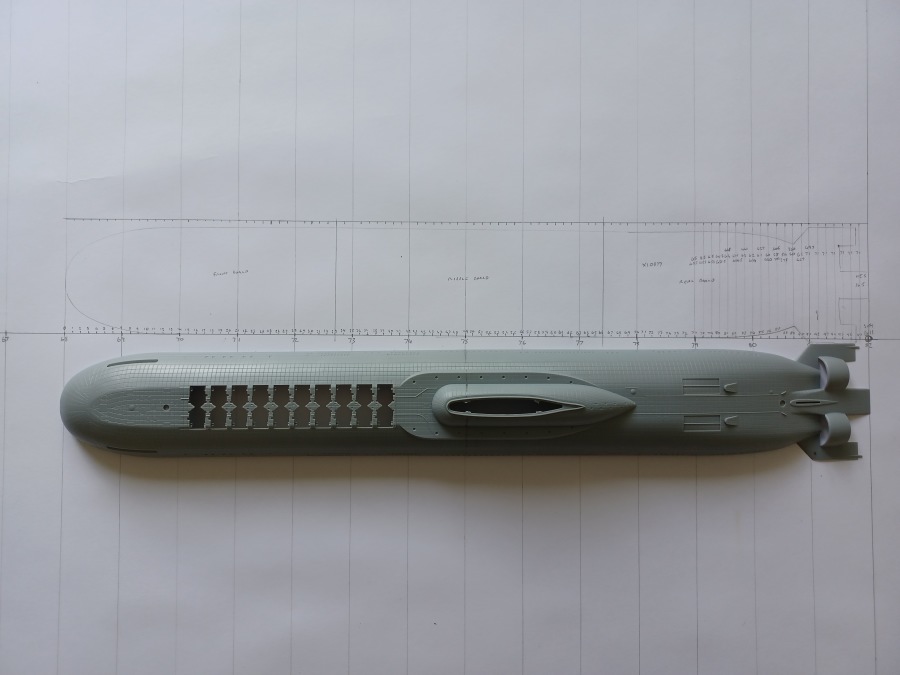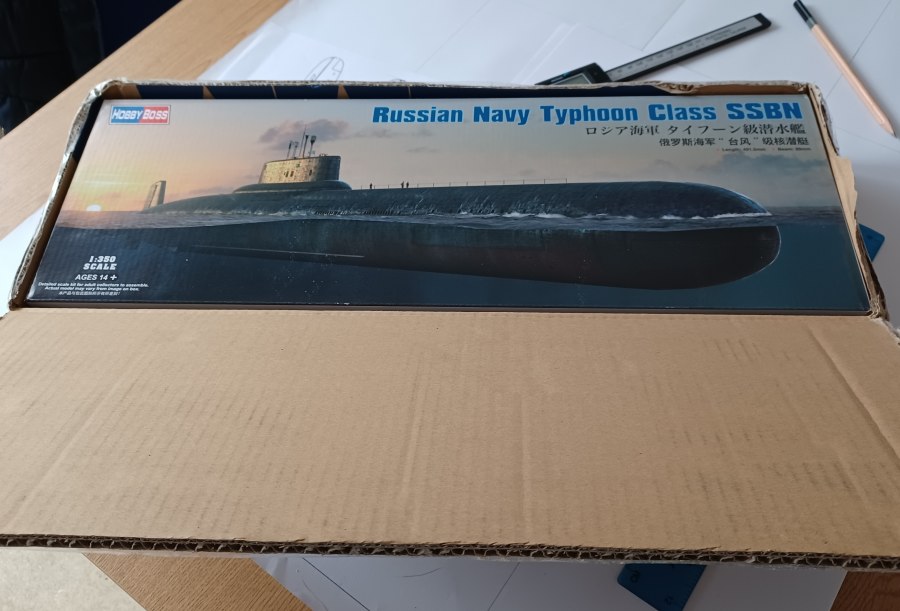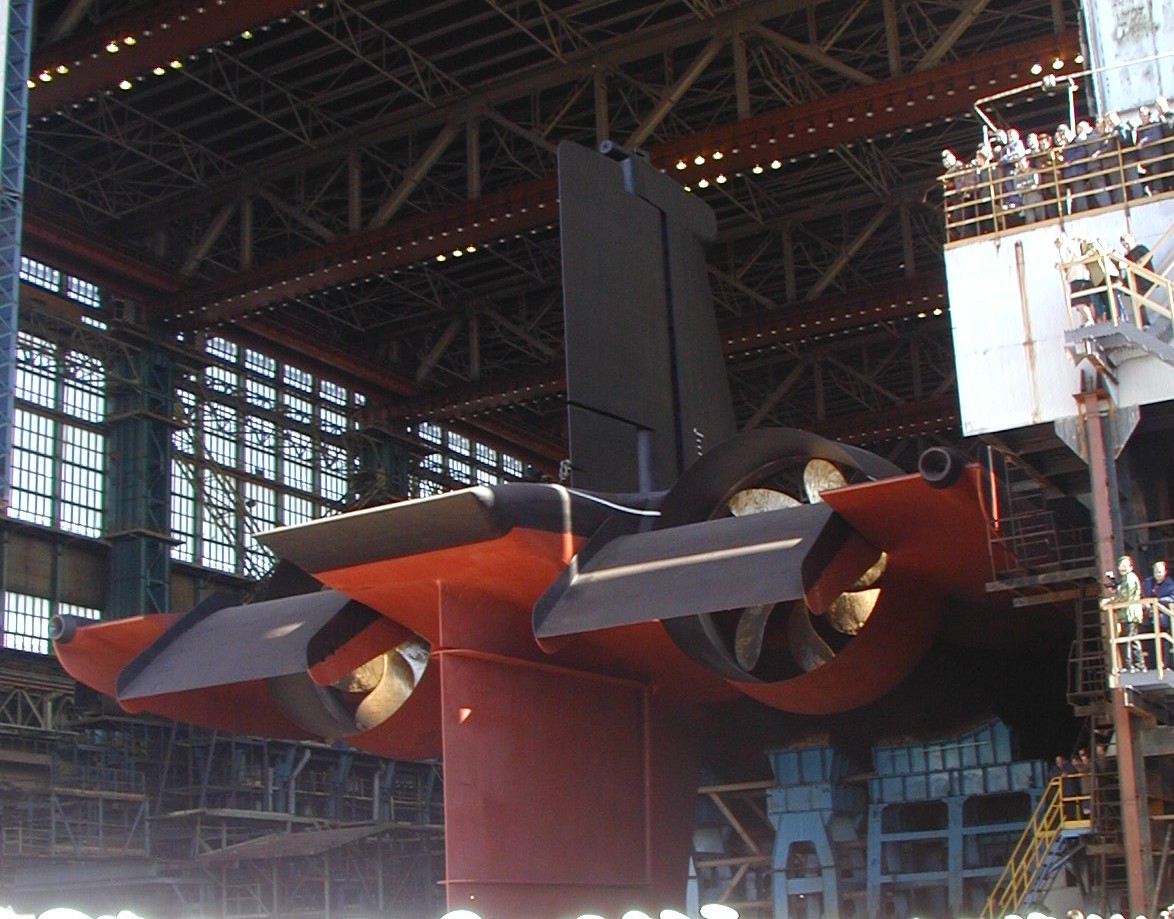- Details
- Category: Project 941
To start building the submarine model, many measurements need to be taken and plotted out on a flat surface. Bearing in mind that the model would be over 3 metres long, it would need to be built in sections, especially as my kitchen table is just 1.2 metres long.
So to start this off, I bought three MDF panels, each just over 1200mm long and 600mm wide. These were covered with paper from an A0 roll, taped at the back. The Centreline was measured and marked out along their length. I ended up with three boards that looked like this:

I then marked out a piece of A3 paper for the 1:350 model, and drew a centre line. I placed the model's top hull half against the centre line and drew around it with a pencil. The outline was marked off at 5mm intervals and each interval was numbered - from 0 to 99. Later on I transferred this to the boards as a reference.

Each 5mm interval at 1:350 equals a 35mm interval at 1:50, so next step was to mark out the boards with the intervals 0-99.

From this framework, measurements could be checked and plotted. Some re-work will be required to get the curves correct.

Bow Section

Middle section

Tail Section
in the tail section you can see I have added some detail that is not on the model the tail section will need some fettling before it is ready to build upon.
The next step is to plot the base of the sail - I have marked roughly where it ends on the tail baseboard.
- Details
- Category: Project 941
So the model arrived from Bulgaria in very good condition. Here is a picture of it in the packaging on arrival:

The description on the box was informative and amusing:

Kit is well detailed though not 100% accurate. For instance, the walkway around the sail does not come so far forward and there is detail missing from the tail section, but overall a good starting place.

I pencilled on the midpoint of the model to match up with the RVjunkie image.

I will eventually build up this model when I have finished using it as a measuring pattern for the 1:50 model, since it is a reasonable size.
More here on that when it happens.
- Details
- Category: Project 941
Below are the measurements I have arrived at:
|
Project 941 |
Real life measurements where known | 1:350 model measurements |
Decided model measurements at (1:350)* |
Equals 1:1 scale |
Equals 1:350 scale |
Equals 1:200 Scale | Equals 1:100 scale |
Equals 1:72 scale |
Equals 1:50 scale |
|---|---|---|---|---|---|---|---|---|---|
| metres | mm | mm | mm | mm | mm | mm | mm | mm | |
| Overall Length | 172** | 492 | 492 | 172200 | 492 | 861 | 1722 | 2391.7 | 3444 |
| Hull Length (bow to prop cowls) | 159*** | 460 | 460 | 161000 | 460 | 805 | 1610 | 2236 | 3220 |
| Beam at waterline | 23 | 60.4 | 64.4 | 22550 | 64.4 | 11275 | 225.5 | 313 | 451 |
| Maximum beam | 24.7*** | 64.2 | 70.5 | 24660 | 70.5 | 123.3 | 246.6**** | 342.5 | 493 |
| Draft - waterline to bottom | 12 | 34.3 | 34.3 | 12022 | 34.3 | 60 | 120 | 167 | 240.4 |
| Hull height | 16 | 47 | 47 | 16450 | 47 | 82.7 | 164.5 | 228.5 | 329 |
| Sail base max width | 24.2 | 26.3 | 9213 | 26.3 | 46 | 92.1 | 127.9 | 184.2 | |
* Where there is disagreement between the measurement taken from the model and other sources with real life images, I will go with the real life image measurement
** measurement is given as 172 metres in most cases, some sources say 175 metres.
*** Rough scaling from an overhead image
****Engel 1:100 model is 1725mm long and 247mm wide
- Details
- Category: Project 941

A picture of the refitted TK-208 Dmitriy Donskoy - Some inspiration for the project ahead.
Below is the drawing image from the RVjunkie site:

A section drawing from another source:

more side views:



All images were found on the internet and are copyright of their respective owners.
- Details
- Category: Project 941
The Typhoon nuclear ballistic missile submarine was designed by the U.S.S.R. (CCCP) in the mid-1970s both as a counterbalance to the U.S. Navy's Trident missile program and as a way of making the Soviet submarines more survivable by hiding them under the Arctic ice-cap. Nuclear submarines had been operating under the ice since the 1950s as it was found to be difficult to track other submarines using sonar or satellites in these conditions. In open water the Soviet submarines could be followed by U.S. and British hunter-killer submarines whose job it was to sink them before they'd loosed off any of their missiles. If they hid under the ice however they were relatively safe.
But operating under the ice presented the obvious problem of how to get through the ice to fire the missiles. Typically submarines had to find weak points in the ice in order to surface. Firing the missiles without first breaking through thick ice would not be a good idea so the new submarine had to be built strong enough to surface through the ice at a moment's notice without having to find a weak point first. This meant that the new submarine would have to be very large and strong, in fact the Typhoon is by far the largest submarine ever built. It is often pointed out that the U.S. Ohio class submarines, themselves large and impressive boats, are even longer than the Typhoon. This is true but the difference lies in width, height and overall displacement. The Typhoon is simply so enormous that no other submarine is comparable.

Since the first example entered service in the early 1980s the boats have been surrounded by secrecy. Russia made no secret of the new type's existence and relative importance, but of course almost every detail of the new boat was closely guarded. How much western intelligence knew about the Typhoon is unclear, but in the public sphere there was a lot of speculation about the new boats which entered service at the height of the Cold War. NATO opted to classify these boats as TYPHOON Class SSBN allegedly because that's what the Soviet Leader Leonid Brezhnev had called it. In navy service however it was known as the Project 941 Akula class. Akula is Russian for Shark. The Typhoon should not be confused with the Russian submarine that NATO calls the AKULA, referencing the Project-971 ‘Shchuka-B’ class, which is a much smaller submarine. Originally it's thought that ten boats were planned, but only six were completed, the seventh (TK-210) being scrapped in the yard whilst only 40% constructed.

Originally, the submarines were designated by their hull numbers only. Names were later assigned to the four vessels that were retained by the Russian Navy, which were sponsored by either a city or company. The submarine class, in order of their construction, are:
TK-208 'Dmitriy Donskoy' - Launched 1979, Updated in the mid 2000's and last remaining in active service - testing the RSM-56 (SS-NX-32) missile.
TK-202 - Launched 1982, retired 1999, Scrapped.
TK-12 Simbirsk - Launched 1983, retired 1996, Scrapped.
TK-13 - Launched 1985, retired 1997, Scrapped
TK-17 Arkhangelsk - Launched 1986, Held in reserve at port, Effectively retired
TK-20 Severstal - Launched 1989, Held in reserve at port, Effectively retired
TK-210 - Not completed, scrapped at yard
The original nuclear missiles developed for these subs, the R-39 Rif (SS-N-20 Sturgeon), have also been removed from service. The Typhoons have been replaced in their role by the smaller Borei class subs for active duty
A fictional version of the Typhoon submarine was depicted in the hollywood movie The Hunt for Red October which was released in 1990. It was based on a Tom Clancy novel of the same name. Naturally a lot of speculation and some fictional technology made it into the film, the Red October design was based on what was known in public about the sub at the time, as such it is very different from the real thing.
Typhoon details
Unlike other submarines which have a central pressure hull, the Typhoon class has two large pressure hulls side-by-side along the length of the boat. There are also three more smaller pressure hulls mounted slightly above these two on the centre-line. The forward one of these is the torpedo room, the centre one located directly beneath the sail is the command centre and the rear one is for the steering gear.
The Typhoon class is a ballistic missile submarine so she is not designed to attack other submarines or ships, but she is still armed with a respectable load of torpedoes for self defence. There are six 533mm (21") torpedo tubes which are mounted in stacks of three either side of the centre-line in the bow. They can fire regular Russian heavyweight torpedoes like SAET-60M, 53-56K, SET-65 and USET-80. They can also be used to fire the famous Squall super cavitating rocket torpedo and the nuclear armed SS-N-15 STARFISH anti-submarine missiles which are equivalent to the U.S. Navy's SUBROC.
One boat, Dmitri Donskoi, has been refitted with an additional 12 x 533mm torpedo tubes mounted in an arc (6 either side of the original tubes) outside the pressure hull. These are used to fire decoys such as the MG-74 Corundum. Above the torpedo room is the main access hatch which opens up to the top of the submarine. Just in front of it is the distinctive red and white high-visibility marker buoy which would be released if the submarine was in trouble. Also in the bow, mounted just below the torpedo tubes is the massive MGK-500 'Skat' (NATO: SHARK GILL) sonar system. This is a circular array which is complemented by flank passive arrays. The forward retractable hydroplanes are mounted either side of the torpedo room, and there is a steerable 750 kW thruster mounted on the lower starboard side. This retracts into the outer hull when not in use, and allows the boat to manoeuvre in port. The matching port-side thruster is mounted at the stern. The forward central pressure hull stops immediately behind the torpedo room to make space for the main array of twenty R-39 Rif (SS-N-20 STURGEON) ICBMs. They are 16m long, weigh 75 tons each and carry ten 100 kiloton yield MIRVs with a range of up to 8,300km (5,200 miles). They are arranged in two rows of ten. Unlike on other SSBNs the missiles are not actually carried in the pressure hull, meaning that all the space around the missile silos is free-flooding with water. Each missile tube has a hydraulically operated outer cover and then a sealing inner lid which hinge outwards together along the top of the casing.
Even though the Typhoon is the largest submarine in the world, it carries fewer ICBMs than the equivalent U.S. Navy Ohio class submarines which carry 24. However the warhead number is 200 (20x10 warheads) compared to the Ohio's 192 (24x8).
Buried within the outer casing (the submarine has a 'double hull' configuration) and running either side of the missile tubes are the main pressure hulls which run most of the length of the hull. These hulls feature long and comparatively wide corridors and have at least two floors. Behind the line of vertical missile tubes the central pressure hull starts which contains the control rooms and captain's accommodation. This sits slightly above the two main pressure hulls and is connected to both. The control room is situated immediately below the forward part of the massive sail and is similar to those on other large submarines. There are two periscopes, the smaller needle-thin attack scope furthest forward, and the larger search scope at the back of the control room. These hydraulically operated optical periscopes retract through the control room. Going slightly further aft there is a ladder which leads up through a cylindrical tube to the top of the sail. Although the sail is massive, it is jam-packed like on other submarines and there is barely room at the top for the fair-weather bridge position. In fact the bridge position has the search periscope coming right up through the middle. The front section of the sail houses a sonar with a small bad weather conning cabin above it. This has wooden slatted floors and removable forward windows and is completely flooded when the boat submerges. Either side of the sail is a large escape chamber which can accommodate an incredible 85 men in the event of abandoning ship. The ship's crew of 162 men (52 officers, 85 non-commissioned officers (NCOs) and just 25 ratings) would divide between the two chambers. These are entered from the bottom somewhere near the junction of the central control room pressure hull and the main pressure hulls running along each side of the boat. The two main pressure hulls increase in diameter at they run aft to where the reactors are.
Like many Soviet submarines there are two reactors. Each of the OK-650 reactors can generate 190MW and are used to drive steam turbines which in turn drive the seven-bladed screw-back propellers at the stern. The Soviet reactors are smaller than their U.S. counterparts for a given size and the large diameter hull of the Typhoon allows a whole deck-level above the shielded reactor core. Outside the hull large water scoops feed the secondary loop of a natural circulation cooling system which eliminates the need for noisy pumps when the submarine is operating at slower speeds. Together with the Anechoic tiles which cover the boat and the slow-turning shrouded propellers this makes the boat much quieter than the previous generation of Soviet boats. The screws (propellers) turn in opposite directions and are mounted far apart with the moving hydroplanes mounted immediately behind each one. The rudder is massive and split into an upper and lower vertical stabilizer, with the upper one mounted further forward than the lower one. The rear section of the submarine also mounts not one but two towed sonar arrays (three on the upgraded TK-208 Dmitriy Donskoy - see picture below) and there are two hangers for towed communication buoys in the aft casing approximately over the reactors.

Images and text adapted from internet sources. Any new pictures or information on the submarines is very welcome.
